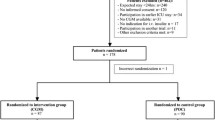Abstract
Blood glucose management is one of the important therapies in the intensive care unit (ICU). However, blood glucose management using the sliding-scale method increases the workload of ICU nurses. An artificial pancreas, STG-22, has been developed to continuously monitor blood glucose levels and to maintain them at appropriate levels. In this study, we examined the hypothesis that compared to conventional methods, blood glucose management using the STG-22 reduces the workload of ICU nurses and has a positive impact on awareness regarding the management of blood glucose. This study included 45 patients who underwent elective surgery and were treated at the ICU postoperatively. The patients were separated into the following two groups: (1) blood glucose was maintained using the STG-22 (AP group) and (2) blood glucose was maintained using the sliding-scale method (SS group). In addition, a questionnaire was developed for an awareness survey of ICU nurses (N = 20). The frequency of blood sampling and number of double checks were significantly lower in the AP group (1.3 ± 1.4 vs. 8.9 ± 8.1 times/admission, P < 0.001; 1.0 ± 1.4 vs. 9.8 ± 8.5 times/admission, P < 0.001). The time needed for glucose management per admission was significantly shorter in the AP group (9 ± 13 vs. 27 ± 24 min/admission; P = 0.003). Use of STG-22 for glucose management in the ICU increased the degree of attention given by nurses to glucose management and contributed to an improved sense of security. In conclusion, using the STG-22 in the ICU reduces the workload of ICU nurses compared to using the sliding-scale method. It also contributed to the reduction of the ICU nurses’ anxiety related to the management of blood glucose.
Similar content being viewed by others
References
Lipshutz AKM, Gropper MA. Perioperative glycemic control. Anesthesiology. 2009;110:408–21.
Hanazaki K, Maeda H, Okabayashi T. Tight perioperative glycemic control using an artificial endocrine pancreas. Surg Today. 2010;40:1–7.
van den Berghe G, Wouters P, Weekers F, Verwaest C, Bruyninckx F, Schetz M, Vlasselaers D, Ferdinande P, Lauwers P, Bouillon R. Intensive insulin therapy in the critical ill patients. N Engl J Med. 2001;345:1359–67.
Brunkhorst FM, Engel C, Bloos F, Meier-Hellmann A, Ragaller M, Weiler N, Moerer O, Gruendling M, Oppert M, Grond S, Olthoff D, Jaschinski U, John S, Rossaint R, Welte T, Schaefer M, Kern P, Kuhnt E, Kiehntopf M, Hartog C, Natanson C, Loeffler M, Reinhart K. German Competence Network Sepsis (SepNet) Intensive insulin therapy and pentastarch resuscitation in severe sepsis. N Engl J Med. 2008;358:125–39.
NICE-SUGAR study investigators. Intensive versus conventional glucose control in critically ill patients. N Engl J Med. 2009;360:1283–97.
Bellomo R, Egi M. What is a NICE-SUGAR for patients in the intensive care unit? Mayo Clin Proc. 2009;84:400–2.
Okabayashi T, Nishimori I, Maeda H, Yamashita K, Yatabe T, Hanazaki K. Effect of intensive insulin therapy using a closed-loop glycemic control system in hepatic resection patients: a prospective randomized clinical trial. Diabetes Care. 2009;32:1425–7.
Garrouste-Orgeas M, Timsit JF, Vesin A, Schwebel C, Arnodo P, Lefrant JY, Souweine B, Tabah A, Charpentier J, Gontier O, Fieux F, Mourvillier B, Troché G, Reignier J, Dumay MF, Azoulay E, Reignier B, Carlet J, Soufir L, OUTCOMEREA Study Group. Selected medical errors in the intensive care unit: results of the IATROREF study: parts I and II. Am J Respir Crit Care Med. 2010;181:134–42.
Yatabe T, Yamazaki R, Kitagawa H, Okabayashi T, Yamashita K, Hanazaki K, Yokoyama M. The evaluation of the ability of closed loop glycemic control device to maintain the blood glucose concentration in ICU patients. Crit Care Med. 2011;39:575–8.
Yamashita K, Okabayashi T, Yokoyama T, Yatabe T, Maeda H, Manabe M, Hanazaki K. The accuracy of a continuous blood glucose monitor during surgery. Anesth Analg. 2008;106:160–3.
Okabayashi T, Hanazaki K, Nishimori I, Sugimoto T, Maeda H, Yatabe T, Dabanaka K, Kobayashi M, Yamashita K. Continuous post-operative blood glucose monitoring and control using a closed-loop system in patients undergoing hepatic resection. Dig Dis Sci. 2007;53:1405–10.
Dellinger RP, Levy MM, Carlet JM, Bion J, Parker MM, Jaeschke R, Reinhart K, Angus DC, Brun-Buisson C, Beale R, Calandra T, Dhainaut JF, Gerlach H, Harvey M, Marini JJ, Marshall J, Ranieri M, Ramsay G, Sevransky J, Thompson BT, Townsend S, Vender JS, Zimmerman JL, Vincent JL. Surviving Sepsis Campaign: international guidelines for management of severe sepsis and septic shock. Crit Care Med. 2008;36:296–327.
Lee A, Faddoul B, Sowan A, Johnson KL, Silver KD, Vaidya V. Computerisation of a paper-based intravenous insulin protocol reduces errors in a prospective crossover simulated tight glycaemic control study. Intensive Crit Care Nurs. 2010;26:161–8.
Valentin A, Capuzzo M, Guidet B, Moreno R, Metnitz B, Bauer P, Metnitz P; Research Group on Quality Improvement of the European Society of Intensive Care Medicine (ESICM); Sentinel Events Evaluation (SEE) Study Investigators. Errors in administration of parenteral drugs in intensive care units. multinational prospective study. BMJ. 2009;338:b814.
Acknowledgments
This work was financially supported by The Kochi University President’s Discretionary Grant.
Author information
Authors and Affiliations
Corresponding authors
Rights and permissions
About this article
Cite this article
Mibu, K., Yatabe, T. & Hanazaki, K. Blood glucose control using an artificial pancreas reduces the workload of ICU nurses. J Artif Organs 15, 71–76 (2012). https://doi.org/10.1007/s10047-011-0611-7
Received:
Accepted:
Published:
Issue Date:
DOI: https://doi.org/10.1007/s10047-011-0611-7




